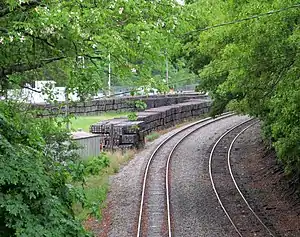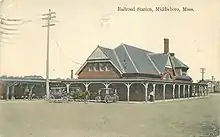Middleborough station
Middleborough station (also called Pilgrim Junction) is a planned MBTA Commuter Rail station in Middleborough, Massachusetts. It is expected to open in late 2023 as part of the South Coast Rail project, replacing Middleborough/Lakeville station for regular service. The station will have a single side platform located inside the wye between the Middleborough Main Line and the Middleboro Secondary.
Middleborough | |||||||||||||
|---|---|---|---|---|---|---|---|---|---|---|---|---|---|
 The planned station site in 2017 | |||||||||||||
| Location | 161 South Main Street Middleborough, Massachusetts | ||||||||||||
| Coordinates | 41.88707°N 70.92287°W | ||||||||||||
| Line(s) | Middleborough Main Line Middleboro Secondary | ||||||||||||
| Platforms | 1 side platform (planned) | ||||||||||||
| Tracks | 2 | ||||||||||||
| Connections | |||||||||||||
| Construction | |||||||||||||
| Parking | 500 spaces (planned) | ||||||||||||
| Disabled access | Yes | ||||||||||||
| History | |||||||||||||
| Opening | 2023 (planned) | ||||||||||||
| Services | |||||||||||||
| |||||||||||||
| |||||||||||||
The Fall River Railroad opened through Middleborough in 1845–46. Three branch lines from Middleborough followed: the Cape Cod Branch Railroad in 1847, the Middleborough and Taunton Railroad in 1856, and the Plymouth and Middleborough Railroad in 1892. The lines were consolidated under the Old Colony Railroad, which constructed a Tudor-style station building in 1887. The New York, New Haven and Hartford Railroad acquired the Old Colony in 1893. Passenger service declined in the 20th century, with commuter rail service to Boston ending in 1959.
From 1984 to 1988, Cape Cod and Hyannis Railroad seasonal commuter and excursion service stopped in Middleborough at the former station, which was demolished in the 1990s. MBTA service on the Middleborough/Lakeville line began in 1997, using Middleborough/Lakeville station to the south rather than the downtown station site. In 2017, a re-evaluation of the South Coast Rail project proposed an interim route via Middleborough, with a new Middleborough station. The site at the Pilgrim Junction wye was chosen in 2018, and a construction contract awarded in 2020.
Station layout
The station is planned to be located inside the wye between the north-south Middleborough Main Line and the east-west Middleboro Secondary, slightly south of downtown Middleborough. The 800-foot (240 m)-long high-level platform will be located on the northwest leg of the wye, with pedestrian access to West Grove Street (Route 28) at its northeast end. A 500-space parking lot will be located inside the wye, with an access driveway running southeast to South Main Street (Route 105) at its intersection with I-495 ramps. Space is reserved for a proposed 400-foot (120 m)-long platform on the southwest leg of the wye (across from the Middleborough Layover, the main layover yard for the Middleborough/Lakeville Line) to serve future shuttle trains to Cape Cod.[1]:37
History

Old Colony Railroad
The Fall River Railroad opened between South Braintree and Fall River in stages from June 1945 to December 1946.[2][3]:403 The connecting Cape Cod Branch Railroad opened from Middleborough to Sandwich in May 1847, and to Hyannis in 1854 as the Cape Cod Railroad.[4][3]:411 The Fall River Railroad merged with the Old Colony Railroad in 1854 to become the Old Colony and Fall River Railroad; it was renamed as the Old Colony and Newport Railroad in 1863 and the Old Colony Railroad again in 1872.[3]:376 The Cape Cod Railroad was acquired by the Old Colony in 1872, serving as its Cape Main Line.[3]:408
The Middleborough and Taunton Railroad opened from Middleborough to south of Taunton on the New Bedford and Taunton Railroad in 1856; it was acquired by the Old Colony in 1874.[3]:398 By 1885, schedules on the Old Colony were arranged to allow commuting from Middleborough.[2] In 1887, the Old Colony built a large Tudor-style station (similar to the still-extant Kingston station) at Station Street, replacing the original Fall River Railroad station on the same site.[5][4][6] Two other stations were located in Middleborough on the Cape Main Line south of downtown: Rock (also known as Rock Meeting House) at Miller Street in Rock Village, and South Middleboro at Spruce Street.[7]
The Plymouth and Middleborough Railroad opened between its namesake cities in 1892 and was immediately leased to the Old Colony. The next year, the Old Colony was acquired by the New York, New Haven and Hartford Railroad.[3]:406 Middleborough served as a rail hub for southeastern Massachusetts, with lines in five directions. Facilities at Middleborough included a freight house, a freight yard, and a roundhouse.[5]
20th century

Passenger service on the lightly used branch to Plymouth was discontinued in 1927; this also ended local service between Taunton and Middleborough, which had operated as a Plymouth–Middleborough–Taunton service (sometimes through-routed to Providence).[8][9][10] Freight service on the Plymouth–Middleborough line, largely for cranberry growers, ended in 1939.[3]:407 Passenger service on the Middleborough–Myricks section of the original Fall River line ended in 1931; freight service ended in 1932, and the line was abandoned in 1937.[3]:401 Rock and South Middleboro stations were closed on July 17, 1938, as part of a massive station closure.
Middleborough was a stop for New York–Cape Cod trains (with a short backup move to reach the station) until 1938, after which the trains ran express between Taunton and Wareham.[11][12] This year-round Cape Codder service ran until 1958, then summers only from 1960 to 1964.[13] Commuter service to Boston (with Middleborough the outer terminus for some trains) ran until June 30, 1959, when the New Haven ceased all passenger service on the Old Colony Division.[2] The bridge over the Neponset River burned soon afterwards, preventing any further service from Boston to the Cape stopping at Middleborough; a Boston–Hyannis train via Stoughton ran during the summer of 1961.[13][2]
The lines north, west, and southeast from Middleborough remained in use for freight service: by the New Haven until 1969, Penn Central to 1971, Conrail to 1997, and CSX since. Freight service southeast from Middleborough was taken over by the Bay Colony Railroad shortline in 1982 and the Massachusetts Coastal Railroad in 2007, interchanging with CSX at Middleborough Yard.[3]:413
MBTA era

Restoration of passenger service was proposed intermittently through the 1960s and 1970s. On October 15, 1979, a special train ran from Braintree to Middleborough to publicize the state's plans for restored service.[14] A 1974 state analysis of restoring commuter rail service indicated that the Middleborough station could be reused.[15] From 1984 to 1988, Cape Cod and Hyannis Railroad seasonal commuter and excursion service stopped in Middleborough at the former station.[16][17] From 1986 to 1996, Amtrak's Cape Codder ran through Middleborough, but like the 1960s trains it did not stop in Middleborough due to the station location. The former station was demolished in the 1990s.[5] The 1887-built freight house was added to the National Register of Historic Places as part of the Middleborough Center Historic District in 2000; it was proposed for restoration in 2011.[6][18]
In 1984, a state-directed MBTA study found that restoration of commuter rail service would be feasible.[19] A Draft Environmental Impact Statement (DEIS) was released in May 1990, followed by a Final Environmental Impact Statement (FEIS) in 1992. Both called for a Middleborough/Lakeville station off Route 105 south of Middleborough on the Lakeville border, rather than reusing the old station site.[20][21] MBTA Commuter Rail Middleborough/Lakeville Line service to Middleborough/Lakeville station began on September 29, 1997; a layover facility was located just west of the wye on the Middleboro Secondary.[13]
South Coast Rail
1980s planning for the South Coast Rail project, which will restore passenger service to Fall River and New Bedford, considered routes via Middleborough, Stoughton, and Attleboro. The Stoughton route was the preferred alternative until the project was cancelled in 2003.[22][23] Planning restarted in 2005; in September 2008, MassDOT released 18 potential station sites, including a "village-style" station in downtown Middleborough.[24] By 2009, the Stoughton route was again the preferred alternative.[23]
In 2017, the project was re-evaluated due to cost issues. The new proposal called for early service via Middleborough by 2022, followed by full service via Stoughton by 2030. A new Middleborough station was to replace the existing Middleborough/Lakeville station, which could not be served by South Coast Rail trains.[25] Middleborough and Lakeville officials were critical of the possibility of abandoning the current Middleborough/Lakeville station - which has attracted transit-oriented development - or requiring its riders to take a shuttle train, as well as possible traffic issues from a downtown Middleborough station.[26]
The January 2018 Draft Supplemental Environmental Impact Report considered three potential operational patterns: a reverse move to serve the existing station, shuttle service from the existing station to Bridgewater station, or a new Middleborough station with a bus shuttle from the existing station. The latter was preferred because it had a shorter travel time than the reverse move, and would not require new double track as the Bridgewater shuttle would.[1]:17 Two possible Middleborough station sites were considered – the former downtown station site, and the wye (Pilgrim Junction) between the Middleborough Main Line and Middleboro Secondary – with the latter preferred for lower costs and less traffic impact.[1]:40 The CapeFLYER will continue to use Middleborough/Lakeville station, as the new station will not have a platform on the Middleborough Main Line. However, the station includes space for a future platform to serve shuttle trains to Cape Cod.[1]:37 As of fall 2020, the MBTA is conducting a study to evaluate the feasibility of implementing Buzzards Bay commuter rail service in conjunction with South Coast Rail.[27][28] If such a service was implemented using the new Middleborough station, then it would likely consist of a separate shuttle train between Middleborough and Buzzards Bay, and would require passengers to transfer between trains at Middleborough, rather than offering a one-seat ride between Buzzards Bay and Boston.
Buildings at 161 South Main Street and 52 West Grove Street were demolished in 2020 to make room for the station and its parking lot.[29] The MBTA awarded a $403.5 million contract for the Middleboro Secondary and New Bedford Secondary portions of the project, including Middleborough station, on August 24, 2020; construction was expected to begin later in 2020 and take 37 months, with a late 2023 opening.[30]
References
- VHB/HNTB (January 31, 2018). "Chapter 2 – Alternatives Analysis". South Coast Rail Draft Supplemental Environmental Impact Report. Massachusetts Department of Transportation.
- Humphrey, Thomas J. & Clark, Norton D. (1985). Boston's Commuter Rail: The First 150 Years. Boston Street Railway Association. pp. 95–96. ISBN 9780685412947.
- Karr, Ronald Dale (2017). The Rail Lines of Southern New England (2 ed.). Branch Line Press. ISBN 9780942147124.
- Weston, Thomas Ward (1906). History of the town of Middleboro, Massachusetts. Riverside Press. pp. 510–512 – via Internet Archive.
- Roy, John H. Jr. (2007). A Field Guide to Southern New England Railroad Depots and Freight Houses. Branch Line Press. p. 192. ISBN 9780942147087.
- Maddigan, Michael J. (December 8, 2009). "Old Colony Railroad Freight House". Recollecting Nemasket.
- Humphrey, Thomas J. (January 2007). "Buzzards Bay Commuter Rail Extension Feasibility Study". Central Transportation Planning Staff of the Boston Region Metropolitan Planning Organization – via State Library of Massachusetts.
- "New Haven Announces New Cuts in Train Service". Boston Globe. August 12, 1919. p. 5 – via Newspapers.com.

- "New Train Schedules on Railroads Sunday". Boston Globe. April 23, 1925. p. 6 – via Newspapers.com.

- "Bus May Be Only Taunton–Middleboro Connection". Boston Globe. November 29, 1927. p. 5 – via Newspapers.com.

- Cape Cod, Marthas Vineyard, Nantucket, and how to get there. New York, New Haven and Hartford Railroad. June 21, 1937 – via Wikimedia Commons.
- Air Conditioned Day and Night Trains to Cape Cod. New York, New Haven and Hartford Railroad. June 1, 1938 – via Wikimedia Commons.
- Belcher, Jonathan. "Changes to Transit Service in the MBTA district" (PDF). NETransit.
- Humphrey, Thomas J. & Clark, Norton D. (1986). Boston's Commuter Rail: Second Section. Boston Street Railway Association. p. 25. ISBN 9780938315025.
- Massachusetts General Court Legislative Research Council (1974). Report relative to railroad service from Boston to Brockton and cape cod. p. 31 – via Internet Archive.
- Pillsbury, Fred (June 30, 1984). "Passenger train service to Cape Cod begins anew: Hyannis, Falmouth—All aboard!". The Boston Globe. p. 23 – via Newspapers.com.

- Cape Cod & Hyannis Railroad Spring Schedule, Cape Cod and Hyannis Railroad, May 27, 1988 – via Wikimedia Commons
- Reece, Eileen (August 15, 2011). "Middleboro hopes to restore historic freight house". The Enterprise.
- "Executive Summary". Old Colony Railroad Rehabilitation Project from Boston to Lakeville, Plymouth and Scituate, Massachusetts: Final Environmental Impact Statement/Report. United States Department of Transportation Urban Mass Transportation Administration. March 1992. p. ES-4 – via Internet Archive.
- "Figure VIII-B7: Middleborough/Lakeville Station Conceptual Site Plan". Old Colony Railroad Rehabilitation Project from Boston to Lakeville, Plymouth and Scituate, Massachusetts: Draft Environmental Impact Statement/Report. 3. United States Department of Transportation Urban Mass Transportation Administration. May 1990 – via Google Books.
- "Figure VIII-B7: Middleborough/Lakeville Station Conceptual Site Plan". Old Colony Railroad Rehabilitation Project from Boston to Lakeville, Plymouth and Scituate, Massachusetts: Final Environmental Impact Statement/Report. 3. United States Department of Transportation Urban Mass Transportation Administration. 1992 – via Google Books.
- Howe, Peter J. (January 24, 1988). "MBTA plans for big increase in rail service". Boston Globe. p. B1 – via Newspapers.com.

- Southeastern Massachusetts Metropolitan Planning Organization and Southeastern Regional Planning and Economic Development District (2012). "Commuter Rail" (PDF). 2012 Regional Transportation Plan. Archived from the original (PDF) on November 12, 2011.
- "South Coast Rail Fact Sheet" (PDF). Massachusetts Department of Transportation. October 2008. Archived from the original (PDF) on September 5, 2015.
- "Notice of Project Change" (PDF). Massachusetts Department of Transportation. March 15, 2017. Archived from the original (PDF) on April 18, 2017.
- Laidler, John (June 16, 2017). "Sharp differences over latest plan for South Coast Rail". Boston Globe. Retrieved June 18, 2017.
- Grady Culhane (3 December 2020). "Study Investigates Possible Cape Cod Commuter Rail Service". CapeCod.com. Retrieved 15 December 2020.
- Ethan Genter (1 December 2020). "New study renews hope for Cape commuter rail service". Cape Cod Times. Retrieved 15 December 2020.
- Roy, Linda (August 6, 2020). "North End industrial site demolished for commuter rail station". South Coast Today.
- "FMCB Approves $403.5 Million Contract for South Coast Rail Main Line Construction" (Press release). Massachusetts Bay Transportation Authority. August 24, 2020.
External links
![]() Media related to Middleborough station at Wikimedia Commons
Media related to Middleborough station at Wikimedia Commons
